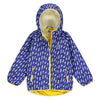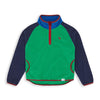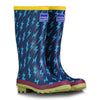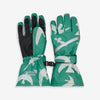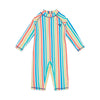
5 Tips for Starting School Sustainably
It's Back to School season and we asked Megan of Our Slow Home to share some of her top tips on making simple changes for a more sustainable start to school.
I can’t quite believe it, but September is fast approaching which for us means my daughter is starting forest school. Alongside me, parents and carers across the country are handed kit lists, school supply lists and are probably googling something along the lines of ‘what do I really need for nursery?’ and finding the best places for school supplies.

It can feel overwhelming, and sometimes even more overwhelming if you are trying to source that list more consciously.
The next 5 tips are to empower you to make some simple changes for a more sustainable start to school. Remember - starting somewhere is a great place to start!
1) Second-hand is not second-best
It is thought that over 1.4 million wearable school uniforms are thrown away each year, a crazy stat that makes me think buying second hand is a bit of a no-brainer. Shopping second-hand has often had a bit of a stigma attached as images fill minds of clothes with rips, stains and buttons missing - in other words, the off-casts that no one wants or knows what to do with.
It’s time to reclaim this for our kids and normalise buying second-hand because this isn’t the case, and the Second-hand clothing market is set to be twice the size of fast fashion by 2030! How amazing is that for the planet?! My daughter has never felt short-changed in buying majority second-hand and it can definitely still be fun.
There are lots of online platforms to buy second-hand uniforms such as Uniformis, and your school may have its own system where parents donate their children’s outgrown uniforms. You could also search on Facebook groups, local mum’s groups, look in charity shops local to the area, and don’t forget the usuals like Ebay, Vinted and Depop too.
Buying and sourcing second-hand does usually take a little bit more time and researching to find what you need, so now is a great time to start!
2) Buy responsibly
If you’ve followed any of my journey you will know that I was so deeply impacted about five years ago watching ‘The True Cost’ documentary that I decided to break-up with fast fashion.
If you are out and about you will no doubt see the fast-fashion tycoons luring you in during the back to school period as supermarkets battle each other with their discounts and low prices. And while yes, you may be able to buy all your children’s school supplies for under £30, someone else has paid the cost that you saved whether that is the planet or people through cheap and unfair labour and cheap materials.
This doesn’t mean we have to spend an obscene amount of money on clothes, but for us buying 80% second-hand allows us to buy the 20% we buy new responsibly. This means buying clothes that are made fairly and from materials that do not come at the cost of the planet.
Buying better also means buying with the intention of something lasting longer - this means buying clothes made of materials built to endure and often means I size up, pick a gender neutral colour so they can be passed on to siblings and friends, and go either without a print or one that is versatile and with slogans that aren’t seasonal.
If you are buying new for nursery and school Muddy Puddles is a great place to start for coats and rainwear. For school uniform, take a look at EcoOutfitters and Ethical Superstore. For shoes take a look at vivo barefoot and Giesswein. And for school backpacks and other accessories why not try Frugi. Don’t be afraid to wait for sales, hunt around for discount codes or referral codes!

3) Snack savvy
I can’t quite believe that I will soon be that lunchbox making mum! A packed-lunch can create so much waste with wrappers and food.
How can you look at what your child loves and adapt it to have less packaging? Could you try your hand at making some bread, I love this no-knead bread from Tin Eats, and these great and freezable lunchbox rolls from The Whole Food Diary. Can you choose foods that are in season, to minimise air miles and usually plastic too. Is there a snack your kids love that you could make yourself?
If your child is repeatedly leaving something try changing portion sizes, or changing the food altogether! It doesn’t need to be overwhelming but start small, if it’s easier for you to grab something packaged from the supermarket, is there something you can switch to that comes in less packaging or could you buy it in bulk?
4) Use what you already have
Ultimately, the most sustainable item is one you already have in your home. Yes it’s true, that plastic Tupperware at the back of your cupboard though not quite as cool as the triple layer flash stainless steel lunchbox is more sustainable and probably works just as well.
Have a hunt around to see if you can find what you need at home before buying. We’re going to be patching up a bag some squirrels got to…. yes, and while I am tempted to buy her a new one and could guarantee she would go wild for a unicorn print, it is just not necessary at this stage. Things may change as the school year goes on, but it’s okay to start the year with some of the crayons broken and a well loved pencil case. This opens up GREAT conversations with our kids that new doesn’t necessarily mean better, and creates such value and connection over the things they own.

5) Re-wear and mend
It’s very normal to want to throw a whole item in the wash after one wear, or if we notice a little paint mark from craft time or a raspberry splurge from snack. Could you spot clean instead? Could you air it outside for a little bit to freshen it up? Does a jumper have a hole or a shirt a missing button?
There are lots of places you can purchase basic sewing kits to have on hand to do a simple bit of mending, and if you’re not seasoned in this why not watch a YouTube tutorial to learn or ask someone more experienced to teach you! Let’s revive the art of mending clothes!
I hope you find these tips useful. It’s a good idea to ask yourselves questions along the way, we’re always learning.
As your child begins their school journey don’t be afraid to challenge systems or raise ideas, or a more sustainable way of doing things. Many schools and parents are open to this. You could ask what the school do with leftover school dinners, maybe they could start composting or maybe there could be a page for lift shares? Get creative and bring your kids on the journey too - I’m sure their little minds are bursting with ideas.


